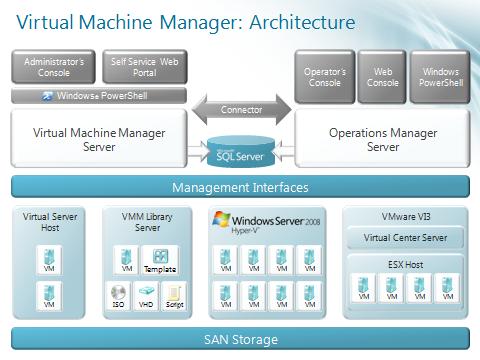VMM 2008 Architecture
If you are in MMS 2008, you've probably seen this architecture diagram:
For folks who did not get a chance to go, here are some of the key architectual characteristics that I'd like to point out:
- On the top-left corner, notice that the UIs (admin console and self-service portal) are all 100% built on top of Powershell. What does this mean? It means that
- Everything you do on the UI can be done through powershell. All actions/jobs are 100% scriptable.
- In addition, if you are a "script-junkie", :-), you can do more via our powershell interface than what's made available on the UI. Yes, power to Powershell!
- Notice the "Connector" sitting between VMM and SCOM, which is part of the new PRO (Performance and Resource Optimization) feature, and that allows a faster message/information sharing between VMM and SCOM.
- In the mid of the picture, notice the horizontal single layer of "Management Interfaces". What is so interesting about that?
- We have abstracted different virtualization platforms and their APIs, and present a set of consistent and platform-agnostic cmdlets and UI interfaces to perform your heterogeneous host and VM management operations.
- It's totally transparent (I mean "no op" here) to you, no matter you are sending an instruction to a Windows Hyper-V host, a VMware ESX host or a Virtual Server host. This is what we call simplified management experience. :-)
- On the lower-right corner, it shows how we're managing VMware ESX hosts via VCS (VirtualCenter Server). Most of the host and VM operations are done directly with VCS from VMM server. Note that VMM server may still need to communicate with ESX hosts directly when there is need for file-level enumeration (for example, Save State or Clone VM, etc.).
Thanks for reading,
Cheng
